[ad_1]
Last September, I drove for four hours from Jakarta to a small town in western Java, staying one night in a Javanese-styled hotel at the foot of Mt. Ciremai, a 3,000-meter volcano on Java. When I got to Cisantana, I journeyed down a stone path, looking for the Mother Mary shrine. It was a welcome surprise to see this Catholic shrine, equipped with a tropical version of the Via Dolorosa—the route believed to have been taken by Jesus through Jerusalem to Calvary—and supported by electricity coming from a nearby Islamic boarding school.
The presence of such a shrine was all the more surprising in West Java, one of Indonesia’s most conservative Muslim provinces, where attacks against Christians, Ahmadis, and other religious minorities frequently make headlines in local news. Attacks against women’s rights, private gay parties, and transgender crowds are not uncommon.
I continued walking past avocado farms, a banana plantation, and cornfields and finally came upon an open space where a handful of Sundanese women and men were working to construct a tomb.
They were very pleasant. “It’s a quiet day today,” an elderly man said to me. They were taking a break and welcomed me to sit in their bamboo hut with a fire stove.
A woman showed me phone videos of the work they did with more than 100 volunteers, who used wooden poles and bamboo to bring several huge stones from a nearby river to this spot, which is inaccessible by road. They called the tomb “Batu Satangtung” or the “Human Stone,” intended for their elderly religious leader and his wife.
I imagined the makers of Stonehenge might have used similar methods two or three millennia ago in England.
The Sundanese people are from West Java, a province of about 40 million. They are the second largest ethnic group in Indonesia, after the neighbouring Javanese. The volunteers I met are not only Sundanese but of the ethnic-religious group Sunda Wiwitan. The name literally means “early Sunda” or “real Sunda.” Its practitioners assert that Sunda Wiwitan has been part of the Sundanese way of life since before the arrival of Hinduism and Islam.
Why were they building the tomb here? Ela Romlah, the woman with the videos, told me that in 1937 and 1938, when Mt. Ciremai was expected to erupt, Pangeran Madrais—then the leader of this group—and his followers climbed the mountain, carrying a set of gamelan instruments. He and hundreds of his musicians played the gamelan on the mountain for months. They believed their music and prayer stopped the eruption. “They then set up a camp at the foot of the mountain. It was here in Curug Goong.”
Madrais was an inspirational cleric, interpreting old Sundanese and Javanese beliefs. He helped establish the community in 1925.
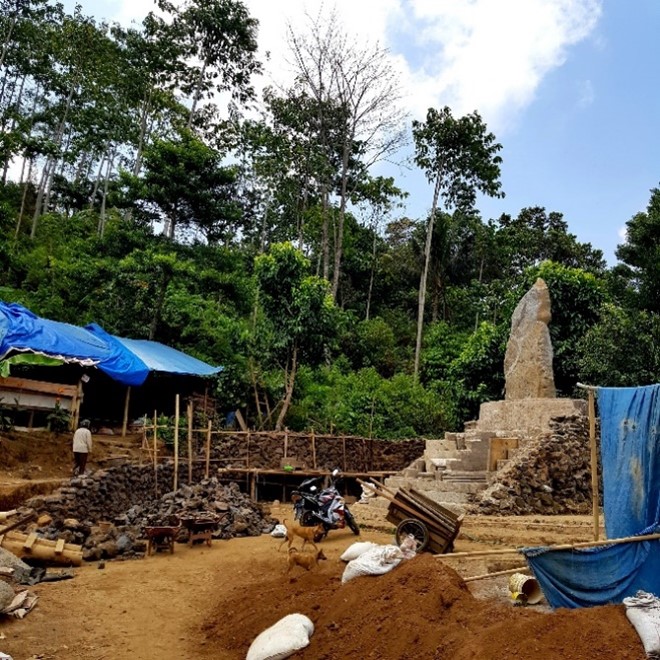
The Sunda Wiwitan tomb site. Image supplied by the author. ©2020 Andreas Harsono/Human Rights Watch
The Dutch colonial officials in charge at the time were not amused to see this kind of independent behaviour. They tried to prevent hundreds of Sundanese people from staying at Curug Goong. But they said nothing when Mt. Ciremai calmed down.
In August 1945, at the end of World War II, Indonesia’s independence leaders adopted a constitution that vowed to protect all Indonesian citizens equally. But they also reached a political compromise with conservative Muslims, including Wahid Hasjim, the chairman of the Nahdlatul Ulama. The agreement, designed to avoid setting up an Islamic state, established the Ministry of Religious Affairs to be “the bridge” between Muslims and the state. The compromise was called Pancasila.
In Garut, about four hours’ drive from Curug Goong, Islamist militants were not satisfied with this and declared the Darul Islam (Islamic State) movement in August 1949, vowing to implement their version of Sharia in Indonesia. From 1950 to 1958, Darul Islam conducted a failed guerrilla campaign in West Java that nonetheless attracted some popular support. They attacked not only the Indonesian military but also religious minorities.
In response, Wahid Hasjim, the minister of religious affairs, adopted a 1952 decree to differentiate between “kepercayaan” (faith) and “agama” (religion). In Indonesian vocabulary, “aliran kepercayaan” is officially used to cover multiple minor religions and spiritual movements. Hasjim decreed that “aliran kepercayaan” are “dogmatic ideas, intertwined with the living customs of various ethnic groups, especially among those who are still underdeveloped, whose main beliefs are the customs of their ancestors throughout the ages.”
Meanwhile, “agama” was defined according to monotheistic understandings. If a community is to be recognised as “religious,” it must adhere to “an internationally recognised monotheistic creed; taught by a prophet through the scriptures.” In this way the decree discriminates against non-monotheistic religions including Hinduism, Buddhism, Confucianism, Bahaism, Zoroastrianism and hundreds of local religions and spiritual movements in Indonesia.
In West Java, the Sunda Wiwitan people faced two serious challenges: the Darul Islam militants, who repeatedly intimidated and attacked them, and the Ministry of Religious Affairs, which actively tried to align “underdeveloped religions” such as theirs with Christianity or Islam.
In 1954, Darul Islam militants attacked the Sunda Wiwitan base in Kuningan. “They managed to burn our paseban (communal spaces) including the kitchen and the garages but fortunately not the main hall,” she said. “They forced our members to convert to Islam,” said Dewi Kanti, a great granddaughter of Madrais.
Similar intimidation and violence took place in neighbouring regencies Tasikmalaya, Banjar, and Garut. Dewi’s grandfather, Pangeran Tedja Buwana, who succeeded Madrais, fled Kuningan to Bandung.
Darul Islam also sent militants into Jakarta. On November 30, 1957, President Sukarno attended a school function at which a Darul Islam militant threw a grenade. Sukarno was unharmed, but six schoolchildren died.
Even after Darul Islam had been militarily defeated, eight Darul Islam militants mingled with a Muslim congregation during a prayer service inside the State Palace on May 14, 1962. They fired shots at Sukarno but missed, hitting one of his bodyguards and a Muslim scholar instead.
Muslim conservatives continued their opposition to smaller religions and spiritual movements. To placate hardliners, Sukarno banned the Indonesian Freemasons (Vrijmetselaren-Loge) along with six so-called “affiliates,” without providing evidence of any illegal links: the Bahai Indonesia organisation, the Divine Life Society, the Moral Rearmament Movement, the Ancient Mystical Order Rosae Crucis, the Rotary Club and the Democracy League, a non-religious organisation considered to be critical of Sukarno. The Rotary Club was accused of being a Zionist group; this was essentially a conspiracy theory intended to connect the Freemasons to the six organisations.
In June 1964, the Kuningan authorities declared Sunda Wiwitan marriages illegal. The Kuningan prosecutor’s office later detained nine believers—a priest and eight young grooms who married in Sundanese Wiwitan rituals—for several months.
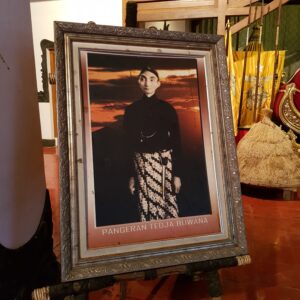
A portrait of Sunda Wiwitan faith leader, Prince Tedja Buwana. © 2020 Andreas Harsono/Human Rights Watch
Anticipating increased hostilities, Tedja Buwana, who had returned from Bandung, left the Sunda Wiwitan faith, joined the Catholic church and used their paseban as a church. His move prompted 5,000 Sunda Wiwitan believers to convert to Catholicism, according to a researcher, Cornelius Iman Sukmana, himself a Catholic in Kuningan, who wrote a book about the Sunda Wiwitan and the Catholic church.
“It was an important decision. My grandfather saved thousands of our members from accusations of atheism,” said Dewi Kanti, referring to massacres of the communists between 1965 and 1969. “We can’t imagine what would have happened if he didn’t do it.”
Decades later, when the situation finally calmed down, many of these Sunda Wiwitan people, including Dewi Kanti, openly, but not offficially, re-converted to Sunda Wiwitan. Many who converted away from Christianity still go to Sunday mass and wear a cross around their necks. But inside their pockets, they also have Sunda Wiwitan pendants (a mountain, an eagle and two snakes).
“It is common in Kuningan to meet a single family with several religions,” said a vendor near the shrine.
As I walked down from the tomb, I wondered if these conversions and re-conversions prove that religious identity is not a zero-sum game. Identity is somehow imagined like a container with a fixed volume; if you have more of one identity, you have less of another. The Sunda Wiwitan people showed me that they could expand the container and have multiple identities. Thinking of it from this perspective, it is no surprise that I found a tropical Via Dolorosa and an Islamic boarding school near the tomb construction.
The 1965 Blasphemy Law
In downtown Kuningan, I drove to the paseban area, looking at the beautiful wooden hall and sipping a smooth ginger-lemon tea while chatting with Okky Satrio Djati, a Catholic Javanese, who had married the Sunda Wiwitan leader Dewi Kanti almost two decades earlier.
Djati and I used to work together in a newsroom during the Suharto era, publishing online samizdat and managing a mobile internet server. He went to Kuningan in 1998 when President Suharto was facing the mass protests at the height of the Asian economic crisis and helped hide political activists fleeing trouble.
Djati is now a Sunda Wiwitan member, speaking Sundanese, burning incense and sometimes performing midnight prayers in a nearby mountain. “He seems to be more Sundanese than me,” said Kanti, with a giggle.
Djati helps his wife deal with the discrimination that many Sunda Wiwitan members face. “My husband chose Catholicism as his official religion,” Kanti said. “But he practices Kejawen faith. If we insisted on marrying with our own (real) religions, we wouldn’t have birth certificates for our children, or at least, not with my husband’s name on them.”
Under Indonesia’s legal system, an ethnic believer cannot put their kepercayaan on the agama column of their national ID cards and thus cannot legally marry unless they change their kepercayaan to a recognised religion. In these cases, they leave a blank space in the religion column of the card and the civil registration office does not recognise paternity because the couples are not officially married.
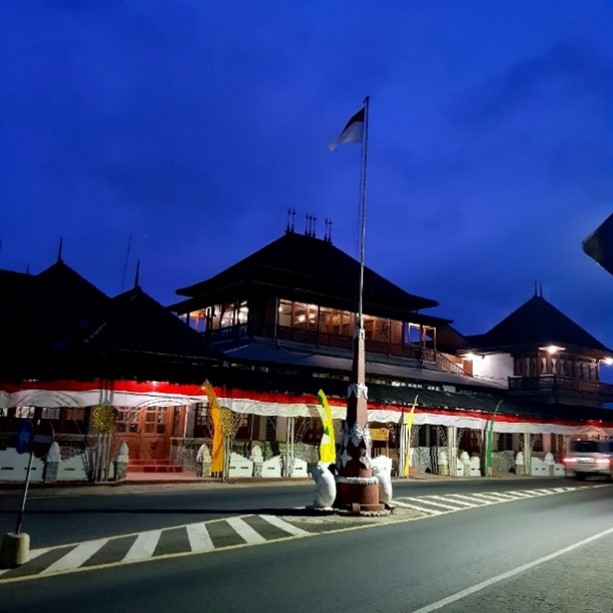
The Sunda Wiwitan “paseban” (house of worship) in Kuningan, West Java, was also used as a Catholic church. © 2020 Andreas Harsono/Human Rights Watch
Problems for religious minorities escalated in January 1965 when President Sukarno issued a decree that prohibited people from being hostile toward religions or committing blasphemy, which is defined as “abuse” and “desecration” of a religion. Sukarno decreed that the government would steer “mystical sects … toward a healthy way of thinking and believing in the One and Only God.” The decree, which gave official approval only to Islam, Protestantism, Catholicism, Hinduism, Buddhism and Confucianism, was immediately incorporated into the Criminal Code as article 156(a), with a maximum penalty of five years in prison. This has had disastrous effects until the present.
After deposing Sukarno, Suharto and his regime enforced the 1952 decree, which also requires a religion to have a holy book, leading to many bizarre stories of “religious alignment.” In Kalimantan, Dayak tribal leaders created the Panaturan –a collection of Dayak ancestral wisdom compiled into a single “holy book.” This required the creation of a clergy, so Dayak priests were trained. Religious rituals once held in fields and homes were moved into new worship halls called Balai Basarah. But most importantly, Kaharingan religious leaders had to choose a permitted religion to align with. They chose Hinduism, and thus became “Kaharingan Hindu.” But do not ask them about Ganesh or karma!
President Suharto’s wrote about his own Javanese Kejawen faith and Islam in his 1989 authorised biography. He described the syncretism common among the Javanese, conducting his Islamic prayers and celebrating Islamic holidays while also meditating in the sacred places of the Javanese traditions when he wanted to make major decision.
On September 7, 1974, three months before the East Timor invasion, Australian Prime Minister Gough Whitlam met Suharto in a villa in Mt. Dieng, Java Island, where Suharto was meditating in the Semar Cave, which is named after a mythical Javanese character with whom Suharto identified. That cave is still regarded as sacred. When I visited in 2019 it was locked—the villa is now a museum where photos of the Suharto-Whitlam meeting are displayed. Showing a more open mind towards religious minorities, in 1978, Suharto created a directorate within the Ministry of Education and Culture to service these local religions, telling the Indonesian parliament, “These kepercayaan are part of our national tradition, and need not to be opposed to agama.”
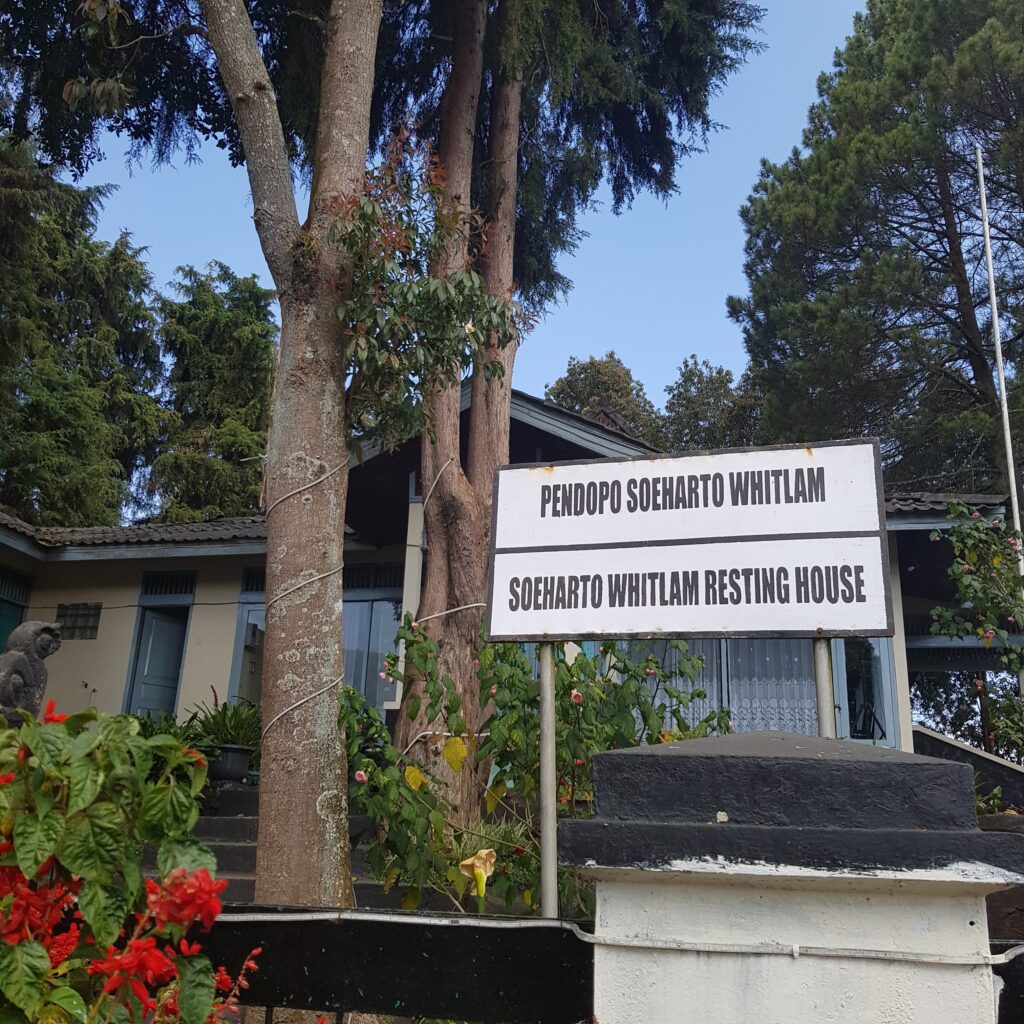
The site of the Soeharto Whitlam meeting is now a museum. Image supplied by the author. Image supplied by the author. ©2020 Andreas Harsono/Human Rights Watch
Yet even under a strongman, the Ministry of Religious Affairs, technically in charge of religions, resisted and maintained its opposition to local religions. They have refused to include kepercayaan within their domain and have promoted the inclusion of these believers into monotheistic realms. One reason Muslim groups refuse to recognise kepercayaan is their concern that the percentage of Muslims (88 percent) in Indonesia may decline, threatening their majority status.
In Kuningan, the new atmosphere under Suharto prompted the Sunda Wiwitan to re-convert to their native faith. Some of them legally left the Catholic church. Some maintain the practice of two religions, living with multiple identities. In 1982, the faith registered with the Ministry of Education and Culture’s directorate, seeking government services along with President Suharto’s accommodation of ethnic believers.
During the weekend I spent talking with Kanti, Djati and other Sunda Wiwitan believers, young and old, women and men, I witnessed the pain of the discrimination they faced and the cost of religious intolerance to people full of tolerance themselves.
It is fascinating to see a small religion resisting the power of the state. While Suharto took some important steps to protect religious freedom, it would have been better still if he had shown the moral courage to rescind the blasphemy law and the idiosyncratic and dangerous definition of religion from the Sukarno era. Sadly, Suharto’s successors have also failed to find the necessary political will.
Post-Suharto Discrimination
Jarwan is the only Sundanese man who stays overnight to guard the Sunda Wiwitan tomb in Curug Goong. He is a well-built man, keeping a motorcycle and several guard dogs in the bamboo hut.
“Someone has to stay here,” he said. “I am the youngest of the elders.”
In July 2020, the Kuningan government sealed off the tomb, declaring that the Sunda Wiwitan group had no permit to build “a monument.” Dozens of Sunni Muslim militants accompanied government officials to seal the tomb, saying that “the monument” is idolatrous.
Sunda Wiwitan members argue that the construction is not a “monument” but rather a “tomb” prepared for two of their elders, Dewi Kanti’s parents, Pangeran Djati Kusumah, and Emalia Wigarningsih. “It’s built on their own land. There is no regulation here to ban anyone to have cemeteries on our own land,” Djati said.
This is not an unfamiliar scene in many Muslim-majority provinces in Indonesia. Rights monitors have recorded hundreds of incidents like this involving Sunni militant groups, whose thuggish harassment and assaults on houses of worship and members of religious minorities have become increasingly aggressive. Those targeted include Ahmadis, Christians, and Shia Muslims. To give just one grisly example, on May 13-14, 2018, Islamist suicide bombers detonated explosives at three Christian churches in Surabaya. The bombings killed at least 12 and wounded at least 50 people. Thirteen suicide bombers also died.
In 2006 the government introduced regulations for building permits for houses of worship, prompting Muslim protesters to demand the closure of “illegal churches.” Hundreds of churches were closed. Some Christian congregations won lawsuits allowing them to build, but local governments simply ignored court rulings. GKI Yasmin Protestant Church in Bogor was shut down in 2008. The congregation won the case at the Supreme Court in 2010 and then-President Yudhoyono asked the local government to reopen the church, but the city government defied the orders, without consequence.
By contrast, in 2010 the Religious Affairs Ministry listed 243,199 mosques throughout Indonesia, around 78 percent of all houses of worship. Recently an ongoing government census using drones and photography has registered at least 554,152 mosques, suggesting that the number of mosques has more than doubled in a decade.
The hardline Islamist preacher, Rizieq Shihab, has just returned to Indonesia from self-imposed exile in Saudi Arabia. He then called on his supporters “to behead blasphemers;” on November 27 an Islamist group attacked a village in Sigi, Sulawesi island, beheading a Salvation Army elder and three of his relatives. The attackers also burned a Salvation Army church and six other Christian-owned houses. No action has been taken against Rizieq for inciting violence, although police arrested him for breaking coronavirus restrictions.
Threats and speeches that incite violence are facilitated by Indonesia’s discriminatory laws and regulations. They give local majority religious populations significant leverage over religious minority communities. Compounding this, institutions including the Ministry of Religious Affairs, the Coordinating Board for Monitoring Mystical Beliefs in Society (Bakor Pakem) under the Attorney General’s Office, the Religious Harmony Forum, and the semi-official Indonesian Ulema Council have issued decrees and fatwas (religious rulings) against members of religious minorities, and frequently press for the prosecution of “blasphemers.”
Recent targets of the blasphemy law include three former leaders of the Gafatar religious community, prosecuted following the violent, forced eviction in 2016 of more than 7,000 members of the group from their farms on Kalimantan. A more prominent target was former Jakarta Governor Basuki “Ahok” Purnama, sentenced to a two-year prison term for blasphemy in a politically motivated case in May 2017. His longtime friend and ally, President Joko Widodo, simply stood by, afraid of the wrath of radical conservatives.
Violence against religious minorities and government failures to take decisive action negate guarantees of religious freedom in the Indonesian constitution and international law, including core international human rights conventions ratified by Indonesia. The International Covenant on Civil and Political Rights, which Indonesia acceded to in 2005, provides that “persons belonging to…minorities shall not be denied the right, in community with the other members of their group, to enjoy their own culture, to profess and practice their own religion.”
Throughout there have been occasional and modest examples of progress. The Rotary Club began operating again in 1970 after Sukarno died. In 2000, President Abdurrahman Wahid, the eldest son of Hasjim Wahid, cancelled President Sukarno’s 1962 decree banning the Freemasons and alleged associate organisations. After more than a dozen members were detained under the law during the New Order, the Bahai community has since been able to revive their network; however, they have been denied permission to build a temple so they continue to worship in private homes.
A major reform took place in 2006 when President Yudhoyono signed the Population Administrative Law, which no longer requires kepercayaan believers to convert to official religions to be listed on ID cards. But many civil servants are still not aware of or ignore the law, so religious minorities face problems if they refuse to choose one of the six religions that these officials recognise. “They simply say you’re a godless woman if you want to keep the [religion] column blank,” said Kanti, whose ID card has a blank space after the word agama.
In Kuningan, Indonesia’s Ombudsman finally helped mediate the dispute between the Sunda Wiwitan community and the local government, prompting the local authorities to lift the seal on the site and permitting the group to continue constructing the tomb.
The Ombudsman’s Office also helped the Dayak Kaharingan, pressuring several local governments to drop decades of discrimination. Ombudsman Ahmad Suaedy said in a webinar: “The key issue is that they [local religious groups] should get public service. The religious minorities should take courage to report their difficulties.”
Related
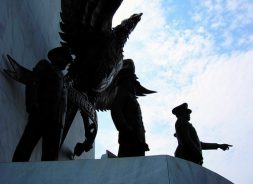
Hypocrisy or imagination? Pseudo-pluralism in Indonesia
The Indonesian government’s approach to Islamic outliers simultanesously marks them as dangerous and fails to protect the vulnerable from harm
In 2017, four Indonesian citizens petitioned the Constitutional Court, demanding the right to have their religions listed on their ID cards. They represented four Indigenous religions including the Marapu (Sumba ), the Sapto Darmo (Java ), and the Parmalim and the Ugamo Bangsa Batak (Sumatra). On November 7, 2017, the court ruled in their favour.
But the Ulama Council objected to the decision. The Ministry of Home Affairs, which issues and manages ID cards, has since failed to implement the court decision. The Ulama Council argued that the ruling “hurts the feeling of the Islamic ummah,” but it is not clear on what legal grounds the ministry refuses to do its duty.
Separately, the Constitutional Court rejected three petitions to revoke the blasphemy law between 2009 and 2018, declaring that religious freedom was subject to certain limitations to preserve public order (former President Abdurrahman Wahid joined the lawsuit in 2009). Those limitations, the court stated in its 2010 decision, were to be defined by “religious scholars,” thereby outsourcing the rights of minorities to unelected members of the majority religion.
There are more than 180 ethnic-religious communities spanning from Sumatra to the smaller islands in eastern Indonesia. They are estimated to encompass around 10 to 12 million people, although the 2010 census recorded only 299,617 people or 0.13 percent of Indonesians claiming to be exclusively ethnic believers. It is still hard and even dangerous to publicly declare one’s religion in Indonesia.
Indeed, it is gruelling work to battle against both government officials and the Sunni ulama. Spineless politicians, feckless government bureaucrats, and narrow-minded ulama officials hamper the development of democracy and human rights in Indonesia.
Jarwan in Curug Goong knows very well that he cannot rely on the government or anyone else to protect the tomb he stands guard over. “We have seen this mistreatment and intimidation for decades. We must guard our sacred places ourselves.
[ad_2]
Source link